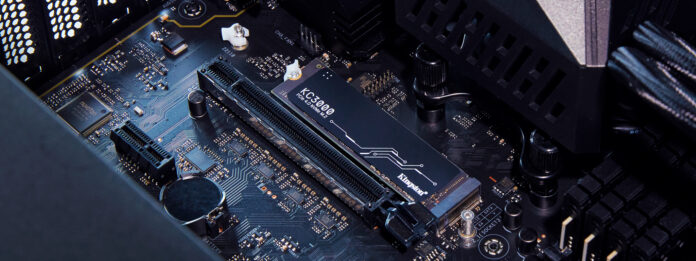For the past decade, PCIe has been the standard interface for connecting high-speed peripheral components to computer motherboards. The fourth generation of this interface, PCIe 4.0, was announced in 2017. However, we didn’t see SSDs or graphics cards using this new technology until Computex 2019.
Today, PCIe 4.0 has sparked renewed enthusiasm for this technological innovation, whether it be SSDs, GPUs, motherboards or high-power expansion cards. But what is PCIe Gen 4? We explain the essentials to you.
What is PCIe Gen 4?
PCIe Gen 4 is the fourth and final generation of the PCI Express specification. The successor to PCIe Gen 3, PCIe Gen 4 is the fastest PCIe generation available on the market today.
What does PCIe Gen 4 do?
PCIe Gen 4 allows systems to connect to high-performance PCIe devices such as GPUs and PCIe NVMe SSDs .
Why is PCIe Gen 4 necessary?
The advancement of PCIe technology is necessary to meet the growing need for a high-speed data bus that can handle increasingly demanding applications and user workloads.
What is the difference between PCIe Gen 3 and PCIe Gen 4?
PCIe Gen 4 doubles the data rate of PCIe Gen 3, allowing PCIe Gen 4 devices to transfer data at much faster speeds. PCIe Gen 3 operates at 8 GT/s (gigatransfers per second), which corresponds approximately to 1 GB/s per PCIe lane. By comparison, PCIe Gen 4 runs at 16 GT/s, or about 2 GB/s (gigabytes per second) per PCIe lane.
What is the maximum bandwidth of PCIe Gen 4?
To understand the maximum bandwidth of a PCIe Gen 4 device, you need to know the number of PCIe lanes it supports.
PCIe devices use “lanes” to transmit and receive data. Also, the more lanes a PCIe device can use, the greater the bandwidth can be. The number of lanes that a PCIe device supports is typically expressed as “x4” for 4 lanes, “x8” for 8 lanes, and so on.
| x1 | x2 | x4 | x8 | x16 | |
|---|---|---|---|---|---|
| PCIe Gen 3 Bandwidth | 1 GB/s | 2 GB/s | 4 GB/s | 8 GB/s | 16 GB/s |
| PCIe Gen 4 Bandwidth | 2 GB/s | 4 GB/s | 8 GB/s | 16 GB/s | 32 GB/s |
Is PCIe Gen 4 backwards compatible?
PCIe Gen 4 is backward compatible, which means that a PCIe Gen 4 device connected to a PCIe Gen 3 system will normally operate at PCIe Gen 3 speeds.
This means that if you purchase a PCIe Gen 4 NVMe SSD today, you can use it immediately in your current system, even if it does not support PCIe Gen 4.
If you upgrade to a PCIe Gen 4 system in the future, you will unleash the full performance of your NVMe SSD PCIe Gen 4.
When will PCIe Gen 4 launch?
PCIe Gen 4 is currently undergoing industry adoption, and many PCIe Gen 4 products are already available in the market. However, only the latest products will support PCIe Gen 4. In the future, PCIe Gen 4 will become the industry standard.
How do I get PCIe Gen 4?
To take advantage of PCIe Gen 4, your CPU, motherboard, and PCIe devices must all support PCIe Gen 4.
Which desktop platforms currently support PCIe Gen 4?
Here are some desktop processors and motherboards that support PCIe Gen 4 that are currently available:
- AMD Ryzen™ 3000 and 5000 Series CPUs
- AMD X570, B550, and TRX40 motherboards
- Intel® 11th Generation “Rocket Lake” and 12th Generation “Alder Lake” processors
- Intel® Z490, Z590, and Z690 motherboards
What is a PCIe NVMe SSD?
PCIe NVMe SSDs are solid state drives (SSDs) that use the high-speed PCIe bus for data transfer, as well as the Non-Volatile Memory Express (NVMe) protocol to communicate with the host system.
Because these drives operate on the PCIe bus, they offer significantly improved bandwidth and faster response times than SATA SSDs.
Does PCIe Gen 4 make NVMe PCIe SSDs faster?
PCIe Gen 3 was unable to support the full bandwidth of high-speed PCIe NVMe SSDs. This effectively created a performance bottleneck for SSDs. PCIe Gen 4 addresses this performance bottleneck, allowing PCIe NVMe SSDs to read and write data at much faster speeds.
What formats do PCIe NVMe SSDs use?
PCIe NVMe SSDs can use different formats such as expansion cards (AIC), M.2 and U.2. PCIe NVMe SSD clients typically only use the M.2 2280 form factor because its slim design allows it to fit easily into desktop PCs and laptops.
PCIe NVMe SSD companies use all three formats, with U.2 being the most popular due to its compatibility with server backplanes.
Conclusion
PCIe 4.0 platforms offer more flexibility and available bandwidth. SSDs that use a PCIe 4.0 interface are ideal for data-intensive workloads. They load apps and games faster while optimizing startup loading time.
PCIe 4.0 also brings power-saving improvements: your device stays cooler in operation while consuming less power. With the emergence of more products adopting PCIe 4.0, the choice between PCIe 3.0 and 4.0 is a no-brainer. PCIe 4.0 will become the industry standard before you know it.



